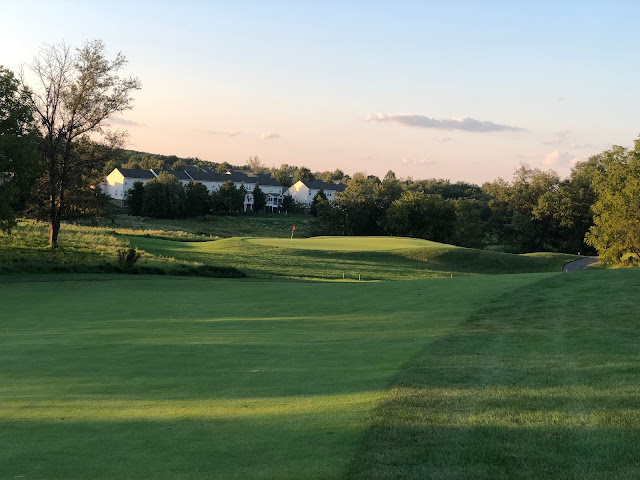What is Mobility? And How to Fix it ⛳
WHAT IS MOBILITY?
(And how to fix it)
INTRODUCTION
A lot has changed in the golf world over the last few decades.
Golf balls have gone from Balata covers and wound cores to Urethane covers and multiple solid cores.
Golf clubs have gone from persimmon to steel to titanium and now carbon fiber.
Golf shafts have gone from inconsistent and unpredictable to incredibly dialed in with precision manufacturing.
Golf fitness training has gone from doing a few curls at the 19th hole to actually getting in a gym and working hard with a trainer.
We see guys like Rory McIlroy, Dustin Johnson, or Brooks Koepka in the gym, moving weight, and getting explosive.
And of course, distance is king.
Hit the ball farther and you’ll be able to score lower. At least that’s the theory Bryson DeChambeau proved right when he won the US Open at Winged Foot.
For the average golfer, copying your favorite player and their gym routines is likely going to be a failure and result in some kind of injury
The reason for that is mobility.
WHAT IS MOBILITY?
Mobility is a term we often hear these days yet I’m not sure many people know what it actually means.
I often hear people interchange the terms, mobility, flexibility, and range of motion. As one of the Golf Fitness Association of America’s Top Golf Fitness Coaches and a certified Mobility specialist, I thought I’d chime in and give some perspective on the topic.
Let’s lay some quick groundwork…
Range of Motion (ROM): Range of Motion refers to the degree to which a joint can move
Flexibility: The ability for a muscle to relax, yielding to a stretch force
Mobility: The ability to freely control movement and quickly adapt to change
Mobility comes from the Latin, Mobilitas which means mobility, activity, speed, rapidity, quickness, changeableness, fickleness, and inconstancy.
True mobility is the ability to go anywhere and do anything. Mobility is being ready for what life throws at you, regardless of when or where. It means the ability to adapt to changes thrown your way and make those changes quickly.
True mobility was a characteristic our ancestors demonstrated beautifully, especially back in the days of our hunter-gatherer ancestors when we were always on the move.
If you were mobile, you would adapt, change, and continue on with life. If you weren’t mobile, you’d die because you wouldn't be able to find food or fend off danger.
The good news these days is if you aren’t mobile you aren’t going to die, although it’s going to make many things in life more difficult.
THE MOBILITY MATRIX
I wrote about the concept of what I call the Mobility Matrix in my book Better Golf From the Inside-Out. Download a free copy of the eBook by clicking here
Flexibility without strength results in Hypermobility. While some of us who are chronically stiff and tight may wish we were hypermobile, being hypermobile comes with its own set of problems.
Hypermobility is typically seen in adolescents, particularly females, gymnasts, and dancers who have lean frames, and lots of range of motion. There are of course exceptions as I have worked with many adults who are hypermobile and need to increase strength and stability to reduce pain while improving performance.
The reason too much flexibility without stability can be harmful is that it leaves the body, particularly the spine, susceptible to injury. When swinging a golf club, for example, it becomes easy to overswing and come out of posture.
Reverse Spine Angle in the golf swing is the #1 cause of low back pain and injury, and is typically a result of having enough flexibility to overswing but not enough core stability to stay in posture.
Stability without flexibility results in rigidity and stiffness
This is bad because when we try and swing a golf club, often because the body can’t move freely, the swing is too short, abrupt, lacks power, is difficult to repeat, and often results in soreness after hitting balls.
People who are stiff and rigid tend to have pain because every time they move, their muscles are tugging on something that shouldn’t be tugged on. This is a concept known as the Joint-by-Joint approach made famous by renowned strength coach Mike Boyle and human movement expert Grey Cook which I also covered in my book.
When we lack both flexibility and mobility we become immobile.
Immobility is often the most dangerous place to be in the matrix because it removes autonomy from a person and forces them to rely on others and is often associated with the elderly and people recovering from traumatic injuries.
If we look at the elderly as an example, they aren’t able to move easily, bend, twist, or squat, and lack the strength and endurance to do tasks that were once simple like playing with the kids, carrying laundry up the stairs, or walking the golf course.
And of course, it becomes more difficult to create speed which is a common complaint in older players. If you’re older and reading this, fear not. There is hope. It may be more difficult and take more time and effort but everyone is capable of regaining lost range of motion as long as the ROM wasn’t lost due to something traumatic like surgery or injury that physically changed the capacity of your body. When it comes to mobility, the old adage is true… Move it or lose it.
Mobility is a balance of both flexibility and stability. The result is an athlete that is capable of moving freely, and own control of that movement. These are people who move beautifully with little effort. They are well attuned to their bodies and able to move however needed to perform the task at hand or to hit the shot in front of them.
Some of the best examples of people who are mobile include the world's best golfers and aerial acrobats like Cirque du Soleil performers.
FAULT vs. COMPENSATION
Players who lack proper mobility will almost inevitably face compensations in their golf swing. It's simply something that cannot be avoided. How you move and what your body can and cannot do will have a direct correlation with your ability to swing a club.
Now that doesn’t mean you can’t play great golf if you lack mobility. It just means you're going to need to understand your strengths and weaknesses, build your swing around your strengths, and in tangent work on improving the weaknesses. I know plenty of people who lack mobility but can post a good score but I can also tell you every one of those players wants more mobility so they aren’t so sore and tired all the time.
When you’re unable to move in accordance with your authentic swing, you’ll end up compensating. Your body is really smart. It knows what it can and cannot do. And if you ask it to do something it cannot, it’ll either shift gears and do what it can, or it’ll do what you asked but result in injury.
Let’s use this example…
I want you to drop down and do the splits
That’s right, the splits
Go ahead, drop down and do a split
Did just the thought of trying to do the splits hurt?
That’s because most people aren’t conditioned to be able to do the splits.
We know people can do the splits because we see people like gymnasts do it all the time, but since we don’t ever find ourselves in that position, we lose the ability to do it. Remember, move it or lose it.
If a gymnast wasn’t able to do the splits, they’re surely going to have a hard time performing their routines. Sure, they could learn the basics and be the best they could be, but they won’t be a world-class gymnast. That’s because all world-class gymnasts have mobility.
The same is true in golf.
Great golfers have mobility. Some more than others, but every great player is at least able to get to impact in a powerful, repeatable, and sustainable way.
John Rahm is probably the best example of a player on tour right now who has limited mobility but is able to make it work. If you watch Rahm, he has a very short backswing. That’s because he was born with a club foot and essentially had his ankle fused together shortly after birth.
This lack of ankle range of motion forces him to create a short backswing. If he went any longer, he would come out of posture and lose power. Now because he’s a strong guy and has mobility everywhere else, he’s still able to produce power, stay in posture, get into a great impact position, and do so repeatedly.
This is great hope for all of you reading this!
You don’t need full range of motion to play golf, but it’s important to understand that the better you can move, the better you can play. You’ll be able to adapt to different shots, different lies, and different conditions, and play more throughout the year while experiencing fewer aches and pains.
THE POWER WARM UP
The first thing I teach any of my students or members of the Tour Shot Golf Academy is the Power Warm Up
The Power Warm Up is a daily body-prep routine that only takes 5-10 minutes and has been shown to improve both flexibility and strength over time.
It combines Power Stretching and Power Breathing techniques to strengthen the Mind-Body connection and improve mobility
You will see results both immediately, as well as compounding effects over time the more consistently you do it. I tell everyone, you get out of it what you put into it.
It’s a simple 10-step routine that targets every area of the body and preps you for whatever the day will throw your way
It is best done:
First thing in the morning within an hour of waking up as part of your morning routine
Before hitting balls (even if you already did it earlier in the day)
As a general mobility routine as needed or a great warmup before a workout
SUMMARY
Mobility means the ability to move freely. To perform on command. Anywhere, anytime.
The better you move, the better you’ll play (Move Better - Play Better)
Move it or lose it (work on your mobility daily)
The Power Warm Up is your key to improving mobility (do it daily, and do it again before you hit balls)




Comments
Post a Comment